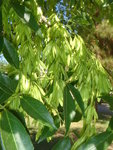I'm having fun following this, I almost wanted to be a botanist, as in botanical taxonomy at one point in time, then I discovered how little you get paid for burying yourself in a herbarium for years at a time.
Many species of trees have both juvenile and mature or adult foliage, one we tend to be familiar with, Junipers, Pines will have juvenile foliage for a year or two before forming needles in bundles. This pattern also is common with Japanese maple cultivars, and a fair number of other plants. Something to keep in mind.
Distribution maps can be misleading if read as absolute, looking at maps of herp distribution in Michigan there were no reports of the snake (blue racer) I was looking at for my county. Yet the snake was there. Turns out, there had been no ''official reports'' recorded. The surveys and distribution maps are limited by the manpower of the survey crew or whether they accept sightings without a voucher specimen (dead plant or animal preserved) to be deposited in a herbarium or museum. Maps that accept reports without vouchers from amateurs can be wildly inaccurate, in terms inaccurate IDs distorting distributions, and ones with very strict record submission rules can wildly underestimate distributions because so few people are allowed submit reports. Statistical errors, inadequate date or faulty data. I'm pretty sure the USDA Plants database, from which the map that Wikipedia sourced the map from is fairly conservative in what submissions it will include in its distribution range maps.
@Hartinez - I checked your link. There is a quote that I think will nail it if your tree passes the test. Wait until leaves are fully hardened off, and only ''mature'' compound leaves, the trait "The leaves are 3 to 5 inches long and are covered in very small fiber like hairs on the backside and is rubbery on the front. "
Feel for the fine velvety hairs below and the rubbery smooth texture of the leaf upper surface. If your specimen has that trait on mature leaves that pretty much cinches the Fraxinus velutina ID.





